Laptop Mag Verdict
The MSI GX60 is an affordable gaming notebook that delivers impressive graphics performance, a full HD matte screen and superb battery life.
Pros
- +
Excellent graphics performance for price
- +
Full HD matte display
- +
Powerful THX speakers
- +
Long battery life
- +
Runs cool
Cons
- -
Chunky design
- -
Small touchpad
- -
Keyboard not backlit
Why you can trust Laptop Mag
Got a need for speed but a little lean on the green? The AMD-powered MSI GX60 gaming notebook is available at a wallet-friendly price ($1,426 as configured) and ships with some impressive trimmings, including an AMD Radeon HD 7970M GPU, a Blu-ray burner and a 120GB SSD paired with a 750GB 7,200 rpm hard drive. Make no mistake; the GX60 packs some surprising punch even with today's most graphically intense games.
Editors' Note: We tested the Winodws 7 version of the MSI GX60. We will update this review once we've tested the Windows 8 version.
Design
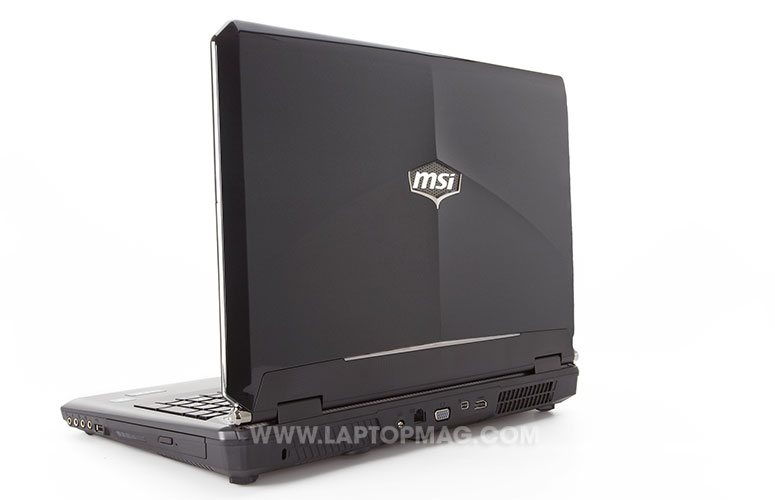
Click to EnlargeThe MSI GX60's chassis is a mish-mash of materials, consisting of both matte and glossy black plastic, as well as aluminum. There's an aggressive aesthetic here as one would expect, but it's as if MSI was trying too hard to make this machine look like a gaming rig. The center of the lid sports an MSI logo on top of a honeycomb pattern, both of which light up white when the GX60 is powered on.
Surrounding the lid's midsection is a panel of glossy black plastic that features four contoured lines protruding from the company's logo. The bottom of the lid has a thin strip of silver sandwiched in between the glossy region and a much smaller section of matte black plastic that sports a textured honeycomb pattern, which reminded us of the scales on a fish.
With its large polygonal power button and horizontally oriented controls bordered by thin strips of red, gazing at the top of the deck conjured images of the control panel on a spaceship's dashboard. A speaker is located on each side of this control panel, and each is partially bordered by a thin strip of chrome. The buttons on the control panel light up orange when you press them.
The recessed SteelSeries keyboard features a full-size keypad. While the palm rest is made of black brushed aluminum, the section of the deck where the keyboard nests uses black glossy plastic. The touchpad is also made of brushed aluminum, while its dedicated click button is comprised of chrome-colored plastic. Five orange indicator lights are perched below the click button, though we wish these lights lit up red, which would match the other color accents on the chassis. Customizable keyboard backlighting would've really spruced the GX60 up considerably, but that would likely add to the cost.
Measuring 15.6 x 10.5 x 2.2 inches and weighing 7.7 pounds, the GX60 is lighter but thicker than both the Digital Storm X17 (16.2 x 10.9 x 1.7 - 1.8 inches/8.4 pounds) as well as the ASUS G75VW-DS71 (16.3 x 12.6 x 0.9 - 2 inches/9.4 pounds). To be fair, the X17 and the G75VW both have larger 17.3-inch displays.
Display
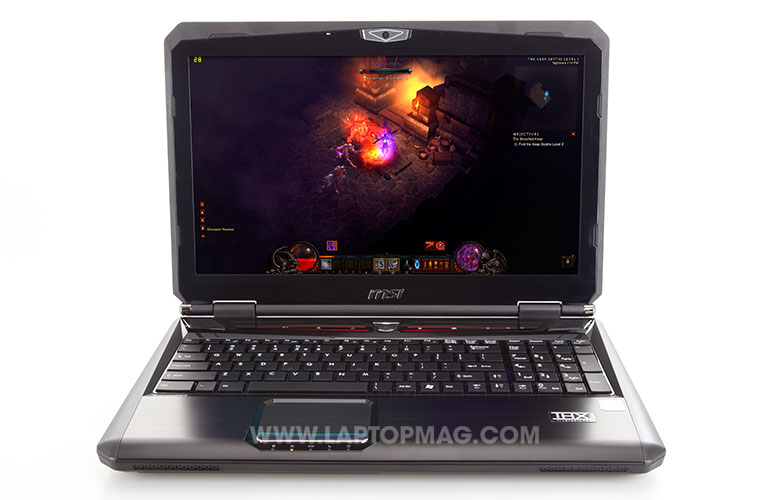
Click to EnlargeThe GX60's 15.6-inch 1920 x 1080 display has a matte finish, making it distraction-free as opposed to reflective glossy screens. The "Life of Pi" trailer looked stunning. Sunlight shimmered majestically and fine details such as the whiskers on a fully grown tiger appeared quite sharp. While playing "Diablo 3," spell effects looked brilliant; fire-based spells burned as bright as the sun while Arcane-based spells produced beautiful violet and magenta hues that made our Wizard appear as if he was drawing his power straight from the deepest recesses of the cosmos.
In our brightness tests, the GX60's display measured 273 lux. This rating is higher than the 248 lux gaming notebook category average. It's also more luminous than both the X17 (239 lux) as well as the G75 (218 lux).
Audio
Click to EnlargeWhen listening to "Mississippi Queen" by Mountain with Creative's THX TruStudio PRO software turned on, guitars and drums sounded meaty and powerful while Leslie West's signature vocals sounded charmingly rugged. When listening to Frank Sinatra's cover of "Luck Be a Lady", Old Blue Eyes' vocals sounded intoxicating, while the highs and lows of wind instruments were distinct and melded wonderfully with the Rat Pack ringleader's crooning.
We wish the speakers were placed towards the bottom of the deck, which would be closer to the user and away from the GX60's display, allowing audio more breathing room.
THX TruStudio PRO has five main settings that you can adjust; Surround, Crystalizer, Speaker, Smart Volume and Dialog Plus. Crystalizer had the strongest effect, and we like that hovering your cursor over the name of each effect will give you a brief definition of it.
Keyboard and Touchpad
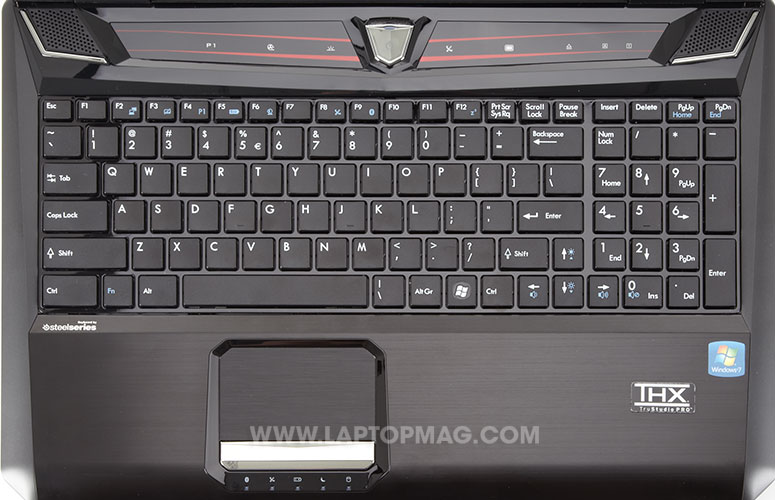
Click to EnlargeThe MSI GX60 sports a SteelSeries keyboard that's spacious and plenty of travel, while the palm rest felt spacious, cool and comfortable. When we took the Ten Thumbs Typing Test, we scored 68 words per minute with a 2 percent error rate. That's on par with our average speed, but typically we get a higher 3 percent error rate.
At 3.3 x 2.8 inches, the Synaptics touchpad felt somewhat cramped. We wish it were bigger, and considering that there's plenty of room on the palm rest, it definitely should have been. The dedicated mouse button felt sturdy and produced a clearly audible "click" when we hit it.
When it came to executing gestures, Pinch and Stretch gave us a little trouble, which was not helped by the fact that the touchpad is on the small side. Rotate and Vertical Zoom worked like a charm though.
We like that there's no Windows key to the left of the Spacebar, which is where your hand will often be while gaming. This eliminates the danger of accidentally pressing it and going back to the desktop.
Heat
For a gaming notebook, the GX60 runs very cool. After playing a full-screen Hulu video for 15 minutes, the touchpad and underside registered 77 and 80 degrees, respectively. At 83 degrees, the G&H keys were the warmest spot of the three. We consider anything above 95 degrees to be uncomfortable.
After playing "Aliens vs. Predator" for 15 minutes with most of the settings at On/High and the resolution at 1920 x 1080, the touchpad remained at a very comfortable 79 degrees. The underside registered 83 degrees and the G&H keys remained the warmest spot of the three at 85 degrees. Overall, the GX60 runs very cool even when you throw heavy workloads at it.
Ports
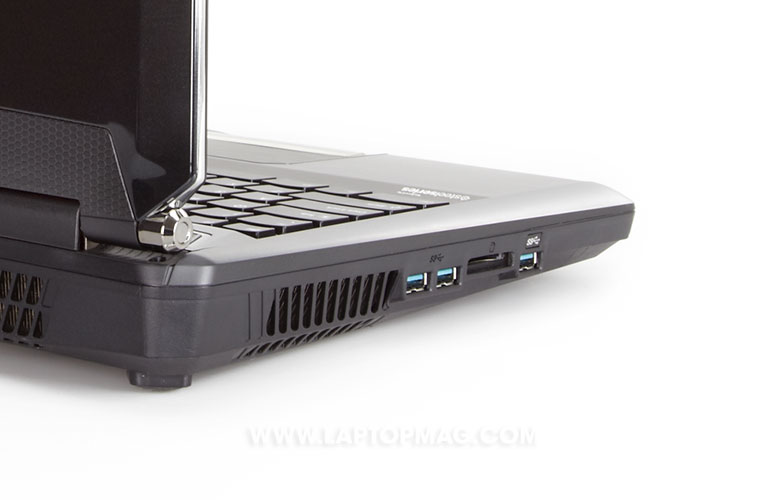
Click to EnlargeThe GX60 features a robust roster of ports. You'll find a trio of speedy USB 3.0 ports on the left side with an SD Card reader sandwiched between them. The right side stores a foursome of audio jacks, along with a Blu-ray burner and a USB 2.0 port. Around back, there's a power connector as well as HDMI, DisplayPort, VGA and Ethernet connectors. The placement of the USB 2.0 port is perfect for plugging in your favorite gaming mouse. This also ensures that the three USB 3.0 ports are free for more heavy duty tasks such as shuttling data back and forth between the machine and external hard drives.
Webcam
Click to EnlargeThe GX60's 1.3-megapixel webcam is paired with CyberLink YouCam software, which allows you to snap photos and record videos at a maximum resolution of 1,280 x 1,024. You can either e-mail clips or upload them to Youtube or Facebook. You can also add custom graphics to your shots. Enabling surveillance lets you record continuously, in time-lapse or when the camera detects motion.
In office lighting, webcam images looked grainy and fuzzy. We had to do a bit of tinkering with contrast and white balance in YouCam to correct the color accuracy. Even so, details like shaving cuts and natural highlights in hair were not visible. In natural lighting, colors like green and black looked dull.
Performance
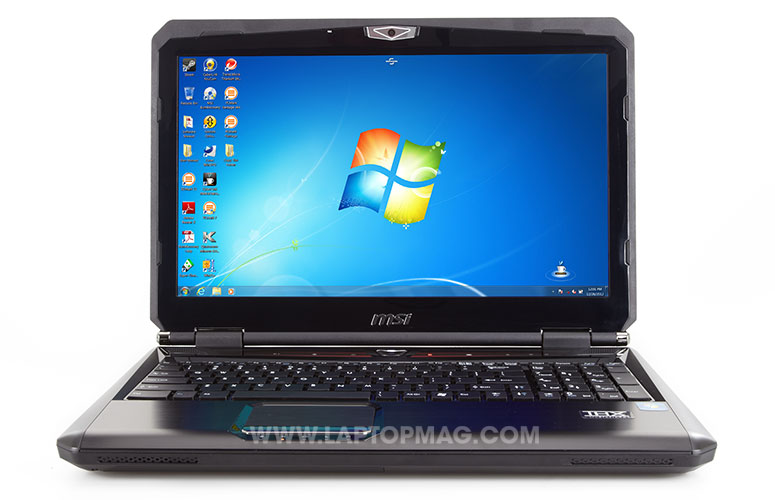
Click to EnlargeThe MSI GX60 is spearheaded by a 2.3-GHz AMD A10-4600M Trinity APU, 8GB of RAM, a 750GB 7,200 rpm hard drive paired with a 128GB SSD, an AMD Radeon HD 7970M GPU with 2GB of GDDR5 RAM and a Blu-ray burner.
When playing "Aliens vs. Predator" with most of the settings at On/High and the resolution set to 1920 x 1080, Fraps recorded framerates between the mid 30s and low 40s, which is impressive.When we hit Alt + Tab to go back to Windows with the game running and opened five tabs in Internet Explorer and Skype, we did notice some slowdowns when scrolling up and down webpages and switching between tabs. However, this didn't affect framerates, which remained in the mid 30s and even touched the low 50s when we went back to playing "AVP" with all the aforementioned stuff running in the background. Simply put, the GX60 is a solid machine that will breathe a little harder if you throw multiple things at it, but it certainly won't choke.
In the PCMark 7 benchmark, which measures a system's overall performance, the GX60 scored 3,041. That's 713 points below the 3,754 category average. However, the Digital Storm X17, which has a 2.3-GHz Intel Core i7-3610QM processor, 16GB of RAM, a 750GB 7,200 rpm hard drive with a 120GB SSD and an AMD Radeon HD 7970M GPU with 2GB of GDDR5 RAM, got a lackluster score of 2,675 in the same test. The ASUS G75, which has the same CPU as the X17 along with 12GB of RAM, dual 750GB 7,200 rpm hard drives and an Nvidia GeForce GTX 660M graphics with 2GB of GDDR5 RAM, tied the GX60 with a score of 3,041.
The GX60 booted Windows 7 Home Premium 64-bit in 50 seconds. That's three ticks slower than the 47 second category average and tied with the X17's time. The ASUS G75 took a more leisurely 66 seconds. All three machines are loaded with the same OS.
In our LAPTOP File Transfer Test, the GX60 took 1 minute and 38 seconds to transfer a 4.97GB mixed media folder. That works out to a 51.9 MBps transfer rate, which is nearly 30 MBps slower than the 82 MBps gaming notebook category average. However, the MSI still writes much faster than both the X17 (34 MBps) and the G75 (30 MBps).
In our OpenOffice Spreadsheet Test, where we make the system pair 20,000 names with their corresponding addresses, the GX60 took 7 minutes and 34 seconds to finish. That's snail-like compared to the 4:25 category average. The X17 took 4 minutes and 52 seconds to complete the task, while the ASUS G75 edged it by a hair with a time of 4 minutes and 51 seconds.
Graphics and Gaming
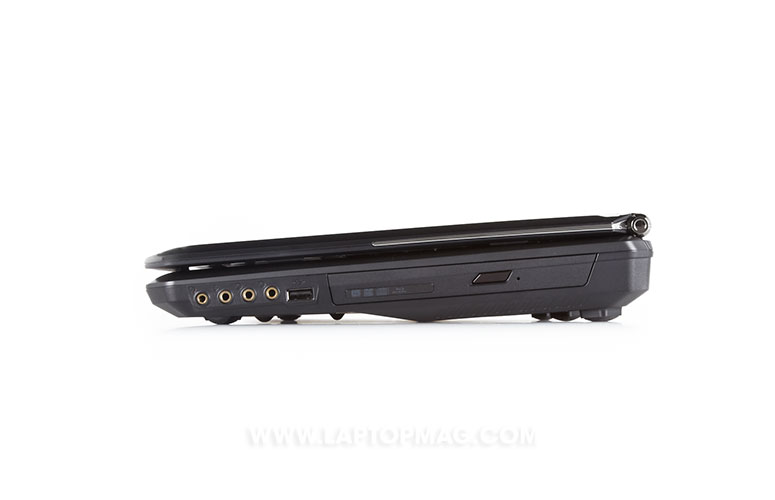
Click to EnlargeThe GX60 sports an AMD Radeon HD 7970 GPU with 2GB of VRAM, on top of the AMD Radeon HD 7660G chip that's integrated into the AMD A10 Trinity APU. In our 3DMark 11 test, the GX60 scored 4,424, which is almost 600 points higher than the 3,874 category average. While this mark is significantly lower than the X17's 5,776, it scorched the G75 (2,533).
The AMD VISION Engine Control Center Software will allow you to choose whether a program will use the more powerful HD 7970 or the integrated 7660G. Opening the software takes you directly to the Switchable Graphics menu. Setting a program to Power Saving will tell it to use the integrated chip. Turning it to High Performance will tell it to lean on the 7970 card. Note that this notebook doesn't automatically switch between integrated and discrete mode depending on the task, as Nvidia's Optimus technology does.
In our 1920 x 1080 "World of Warcraft" tests, the GX60 churned out 77 frames per second with the eye candy on "Good". When we juiced things up to "Full", the framerate dipped to 47. With WoW set to "Good", the X17 cranked out 111 fps. However, it sank to 55 fps with the game on "Full." The G75 owned the GX60 on "Good" as well as "Full", with respective scores of 158 and 88 fps. However, it's worth noting that we tested the X17 and the G75 before the much more graphically demanding "Mists of Pandaria" expansion pack was released.
When we started running our "Batman: Arkham City" test, the tide started turning in favor of MSI. The GX60 averaged 77 frames per second with the resolution at 1920 x 1080 and the settings on Low. That bests the 68 fps category average as well as the G75's score of 41 fps. However, the X17 trumped the field with 101 fps. When we dialed the settings up to the max, the GX60 once again got an admirable count of 47 fps, which is 9 fps higher than the 38 fps average. The G75 brought up the rear with a paltry score of 23 fps at these settings, while the X17 hummed along at a pleasant 55 fps.
Battery Life
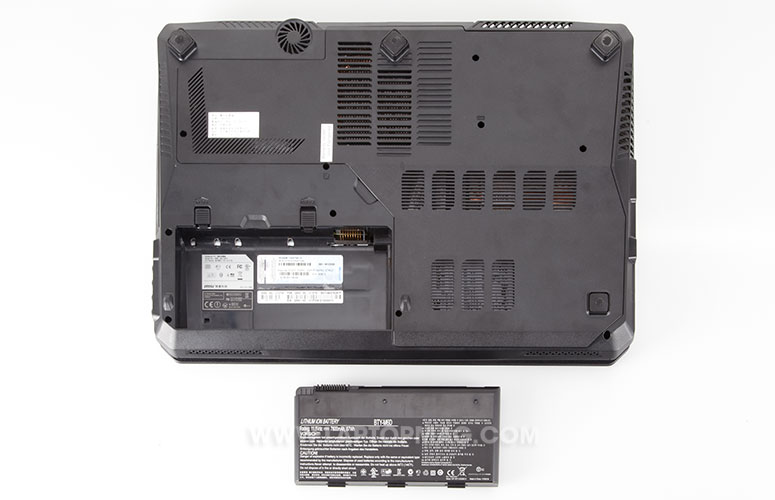
Click to EnlargeOne of the areas where the GX60 shines is battery life. After running our LAPTOP Battery Test, which consists of continuous Wi-Fi surfing with the display's brightness at 40 percent, the GX60's 9-cell juice box keeled over after 5 hours and 46 minutes. That's nearly two hours longer than the 3:40 gaming notebook category average and the same runtime as the Digital Storm X17's score. The ASUS G75 clocked in with a subpar runtime of 3:11.
Software and Warranty
Click to EnlargeWhile the GX60's page on MSI's site states that it should ship with Windows 8, our review unit came loaded with the more familiar and gamer-friendly Windows 7 Home Premium 64-bit. The GX60 is packed with a mix of software that ranges from useful to not. AMD Vision Engine Control Center allows you to adjust display and graphics settings, though we wish it were a bit more streamlined. Corel WinDVD plays DVDs and Blu-rays. Creative THX TruStudio PRO is a fairly simplistic audio enhancement suite.
Cyberlink YouCam lets you snap photos, record videos, add graphics to them and upload your content to Youtube or Facebook.
Click to EnlargeS-Bar is a widget that sits at the top of the desktop and allows you to do a variety of things, like launch programs, adjust settings like Volume and Brightness and more, though its novelty wore off quickly
MSI Burn Recovery creates recovery discs, though when we opened the utility it essentially froze the machine for several minutes. MSI Software Install is a portal from which you can load pre-installed audio, photo, and video editing software as well as Adobe Reader and WinDVD.
Click to EnlargeMSI Battery Calibration claims to boost your battery life, but we have not yet tested this utility.
Qualcomm Atheros Killer Network Manager give you a basic overview of your system's components, tracking CPU and Memory usage as well as bandwidth. Overall, we like the Atheros software, though we wish there were more gamer-friendly programs ready to go out of the box like Fraps, a temperature monitor and easy overclocking software.
A 30-day trial version to a download of Trend Micro Titanium Internet Security 2012 guards your system while you surf the web. Once the trial is up, a free suite like Zonealarm should take care of your security needs.
The GX60 and its installed software are protected by a one-year warranty while pre-installed software is guarded by a 30-day warranty.
Verdict
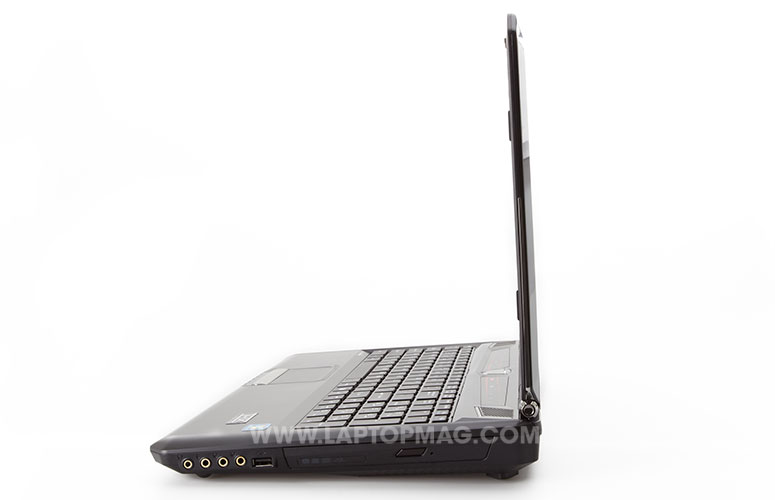
Click to EnlargeBudget minded gamers should no doubt give the GX60 a serious look. Its impressive "Batman: Arkham City" scores alone should tell you that this AMD workhorse is no slouch. The 1080p matte screen makes movies and games look like candy for your retinas, while its keyboard and cool palmrest will be welcome homes for your hands while you taunt your LAN-mates after fragging them. Our main beefs with this rig are its thick (and somewhat gaudy) design, small touchpad, and non-backlit keyboard.
MSI's opus won't touch triple-digit framerates like the recently reviewed Maingear Nomad 17, but that $2,599 system also costs over a grand more than the GX60. Moreover, in some of our gaming tests, this MSI bested the more expensive ASUS G75VW-DS71 and held its own against the Digital Storm X17, both of which cost hundreds more than the GX60. It may not be an unstoppable beast that tears through category averages like a rottweiler through a steak, but at $1,426, the GX60 offers a healthy dose of pew pew while stopping short of making your bank account cry.
MSI GX60 Specs
| Bluetooth | Bluetooth 4.0 |
| Brand | MSI |
| CPU | 2.3-GHZ AMD A10-4600M |
| Card Slots | SD/MMC memory reader |
| Company Website | http://www.msi.com |
| Display Size | 15.6 |
| Graphics Card | AMD Radeon HD 7970M |
| Hard Drive Size | 120GB SSD + 750GB HDD |
| Hard Drive Speed | 7,200rpm |
| Hard Drive Type | SATA Hard Drive + SSD |
| Mobile Broadband | none |
| Native Resolution | 1920x1080 |
| Operating System | MS Windows 7 Home Premium (64-bit) |
| Optical Drive | BD-R |
| Optical Drive Speed | n/a |
| Ports (excluding USB) | Gigabit Ethernet, Ethernet, VGA, DisplayPort, USB 3.0, DC-in, USB, Kensington Lock, HDMI |
| RAM | 8GB |
| RAM Upgradable to | 16GB |
| Size | 15.6 x 10.5 x 2.2-inches |
| Touchpad Size | 3.3 x 2.8-inches |
| Video Memory | 2GB |
| Warranty/Support | 1-year hardware and pre-installed software/30-days included software |
| Weight | 7.6-pounds |
| Wi-Fi | 802.11b/g/n |
| Wi-Fi Model | 802.11 |
